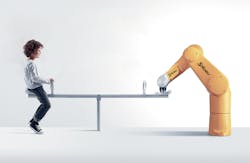At Automation World, we like to know what’s at the cutting edge of automation technology, making sure we share with you the exciting developments you can expect to see coming down the pipeline for your manufacturing operations. One danger in that, though, is that it’s easy to lose sight of where your operations actually are today.
So it is with collaborative robots. We’ve written several articles on developments within this space—including a roundup of collaborative robot activities seen at Automate/ProMat last year, details of a robot revival, their use as an alternative to pure lights-out manufacturing, a panel discussion at our own Automation Conference, and longer feature articles introducing collaborative robots and explaining where they stand with traditional robots. These are just to name a few. Not to mention a new report this week from this year’s Automate show in Chicago about Universal Robots’ use of collaborative robots and augmented reality.
All of that is to say that I was surprised to hear at Automate this week that the overwhelming majority (98 percent) of industrial robot use still falls within Stage 1 of the man-robot collaboration (MRC) spectrum—in which a process is performed by a non-contact robot separated from its operator by a cage or other hard guarding.
Industry is really just beginning to migrate from Stage 1 to Stage 2, where a person helps the robot by feeding in materials, according to Sebastien Schmitt, robotics division manager for Stäubli North America. “The next step is they will engage collaborative robots, where the robot requires a human being to help him,” he said. “We will see more collaboration in that sense.”
At Automate this week in Chicago, Schmitt described all five MRC stages.
In Stages 2 and 3, there’s a shared workspace and contact is possible, but the robot remains in a stationary position. Separated from the robot by a laser (virtual) guard, as the human operator moves closer to the machine, the robot will stop. The difference between these two stages is that the work is performed by only the robot in Stage 2, with the operator entering the area as needed; and the robot and the operator in involved in process realization in Stage 3, with the operator entering the zone regularly during production.
In Stages 4 and 5, the robot is collaborating with a human while in motion. In both cases, there is no separation between the robot and the operator, and both are involved in process realization. In Stage 4, however, the robot stops when it makes contact with the operator; whereas in Stage 5, the robot and operator move simultaneously.
Although increased collaboration will undoubtedly come, Stäubli has not lost sight of the fact that most industrial customers are still rooted in environments where the robots are rooted as well—and kept safely away from humans. So the company’s TX2 robot is prepared to act as a Stage 1 robot today, while being versatile enough to make its way up through the evolutionary stages.
“The benefit of TX2 is that we answer all five stages of MRC,” Schmitt said. “It’s capable of working like a standard robot does today, with high performance, high speed and high repeatability, but also at the highest level of collaboration.”
With the TX2, manufacturers have the flexibility of a system that can evolve over time as they begin to practice and experiment with new ideas. “Collaborative robotics is definitely a technology that’s got some ground today, and it’s going to take more space, be more present in factories,” Schmitt said. “With the TX2, you don’t have to make that choice. It allows you to do a Stage 1, Stage 2, Stage 3, Stage 4 or Stage 5 with the same machine.”
Stäubli’s partners are being more creative these days in the way they design their systems, according to Schmitt. The machine builders will bring end users new features as they see more opportunities and need for collaborative robotics in various environments, he added.
Although the automotive industry has always led others in moving forward with robotics and other technologies, Schmitt said he also sees a strong pull for collaborative robots in medical, sterilized environments.

